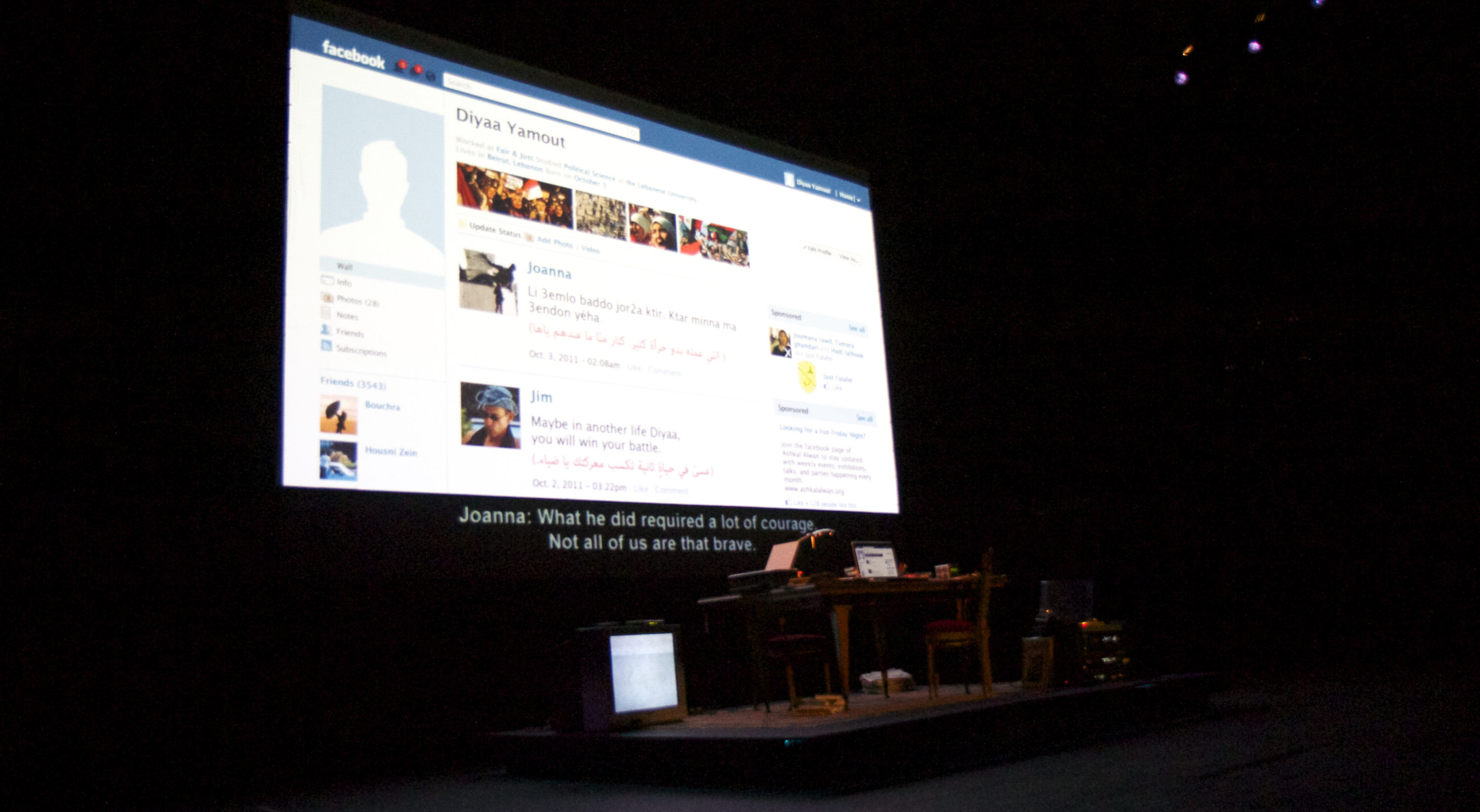Lina Majdalanie, Rabih Mroué
33 tours et quelques secondes
novembernov 22 – 24
Friday november 22
18h30
Friday november 22
21h
Saturday november 23
17h
Saturday november 23
19h
Sunday november 24
14h30
Sunday november 24
17h
Text and direction Lina Majdalanie, Rabih Mroué. With Nagham Abboud, Samir Abou Jaoudé, Thomas Bowles, Edy Gemaa, Raseel Hadjian, Colette Hajj, Wadad Hneine, Paul Khodr, Ibtisam Kishly, Eliane Mallat, Muriel Moukawem, Elie Njeim, Antoine Ozon, Najeeb Zeytouni. Voice over Abdallah Al Machnouk, Gheith El Amine, Raphael Fleuriet, Charbel Haber, May Kassem, Nesrine Khodr, Diran Mardirian, Rabih Mroué, Ziad Nawfal. Voice of the answering machine Lina Majdalanie. Chant Fatima Bazzi. Set design, graphic and animation Samar Maakaroun. Director of photography Sarmad Louis. Technical production and programing Sarmad Louis & Thomas Köppel. Translation Ziad Nawfal. Casting and production Petra Serhal. Editing Najib Zeitouni & Sarmad Louis. Music Ya Jaret El Wadi by Mohammed Abdel Wahab & Le Dernier Repas by Jacques Brel.
Coproduction Festival d’Avignon ; Kunstenfestivaldesarts (Brussels) ; Scène nationale de Petit-Quevilly-Mont-Saint-Aignan ; Festival delle Colline Torinesi Torino Creazione Contemporanea ; La Bâtie – Festival de Genève ; Kampnagel (Hamburg) ; steirischer herbst (Graz) ; Tampere Theatre Festival (Helsinki) ; Malta Festival Poznan 2012 ; The Lebanese Association for Plastic Arts, Ashkal Alwan (Beirut) ; Scène nationale de l’Essonne
Acknowledgements Baroud family ; Janine Baroud ; Stéphanie Bauman ; Ali Cherri ; Sarah Farhat ; Raceel Hadjian ; Ahmad Hafez ; Kinda Hassan ; Paul Khodr ; Sari Louis ; Paul Matar ; Mroué family ; Abdo Nawwar ; Walid Raad ; Christine Tohmé ; Yalda Younes ; Editions Jacques Brel ; Théâtre Tournesol ; Homework Space and all the friends who helped them
In partnership with L'Orient Le Jour
The Théâtre du Rond-Point and the Festival d’Automne à Paris present this show in co-realisation.
Who is Diyaa Yamout, the Lebanese human rights activist, artist and blogger whose suicide shook the nation? We will never really know and this is not what matters. Indeed, what is far more fascinating here is the profusion of assorted reactions on Facebook, the television, and in the form of SMS and answering machine messages
By means of a radical staging, material of a supposedly documentary nature, offered up to the audience without any form of human mediation, is used to build up a virtual portrait of the deceased person, a complex and charismatic individual. We are taken back to the year 2011, and the onset of the Arab Spring movement. Diyaa Yamout's act of desperation lends itself to various interpretations ranging from pseudo-expertise and individual projections, to profiteering and denials. A range of emotional spaces opens up: damaged friendships, intimate memories, and revolt-inducing anguish, all of which are punctuated by words of wisdom in the form of messages from two friends who are not in the know. What strikes us, and indeed what speaks volumes about the state of society, is not so much the tragic event itself but the reactions it stirs up. Inspired by real events, the Lina Majdalanie and Rabih Mroué duo once again holds up a mirror to us that has universal reach. In a subtle, discreetly mischievous way, void of any form of opinion, they give us a dazzling illustration of the extent to which social networks now influence our understanding of the world.
Interview with Lina Majdalanie & Rabih Mroué
In the same place

